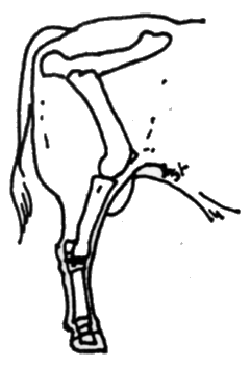
Bull soundness - structural
Introduction
The bull’s fertility is the most important of his traits. You want him to be able to sire many calves, and sire them early each joining season. To do this, a bull must be sound in his structure so that he lasts many years, serving many cows in a short period of time without suffering injury.
Structural soundness is hence an integral part of this fertility. The bull’s ability to remain fertile is dependent on his structural soundness.
Elements of a bull’s conformation are heritable. If a bull shows straight legs and badly grown claws, for example, any sons or daughters kept in the herd may also have these problems.
When structural soundness in a bull is mentioned, most producers think in terms of leg and shoulder structure and the wear and tear on feet and joints. This is very important, but structural soundness includes all visual aspects of the structure of the beast.
To understand all aspects of the bull’s structure and be able to compare one animal to the next, it is wise to adhere to a routine examination. One pattern to use may be this:
- Start with head, neck, brisket, shoulders and front legs and feet.
- Next view along the underside to the sheath, then testicles and the back legs and feet.
- Follow your way up to the pin bones and hips, then the topline and back to the shoulders and neck.
The bull should be viewed from the side, from the front, and from behind. He should be allowed to walk out, and again be viewed from the side, from the front and from behind to confirm any suspicions of poor leg structure.
Let’s look at each of these areas individually.
The head
The head should show reasonable length and width yet not be too large in proportion to the body. A head that is too big could potentially increase calving problems.
The eyes
Some breeds are very susceptible to eye cancer. Eye cancer is a serious condition leading to wastage in cattle and possible condemnation of the carcase. Susceptibility to it is a heritable trait, and while several factors contribute to its onset, exposure of the eye to sunlight plays a major part.
The eyes should be well set into the head to reduce this exposure. There should be a strong forehead over the eye, providing protection from sunlight (hooding). Eyes that bulge out from the head should be avoided. Pigment around the eye will also assist in reducing eyelid cancer in the white-faced breeds.
The muzzle
The muzzle should be wide for efficient grazing. The teeth on the lower jaw should meet squarely with the upper pad. Bulls with overshot jaws (lower jaw protruding) and undershot jaws may have difficulty grazing on pasture, especially when conditions get tough.
The neck
The neck should be of good length and held high. A bull which holds his head and neck low may in fact be straight in the shoulder. This affects the bull’s gait and mobility. A straight-shouldered bull is also likely to be straight in the hind legs, a very serious fault, leading to early breakdown.
The brisket
The brisket is one area in which fat will be deposited. The bull should be trim in the brisket, as he should be throughout his body. Overfat bulls may in fact be light in their muscle, producing progeny with lower yielding carcases.
Bulls that appear fat at sale may have been overfed in their preparation. Overfeeding, especially on high grain rations, may affect the fitness and longevity of the bull, as he carries more weight than his structure is designed for. Overfat bulls may also show temporary reduced fertility, if fat is laid down in the neck of the scrotum.
The shoulders
The shoulders and front leg structure of the bull are shown in Figure 1 below. The shoulders are naturally sloping. A slope of 45–60 degrees is considered acceptable. A beast whose shoulder blade is tipped forward (straight-shouldered) has less angle at the shoulder joint and elbow joint and this reduces the shock-absorbing ability of these front joints.
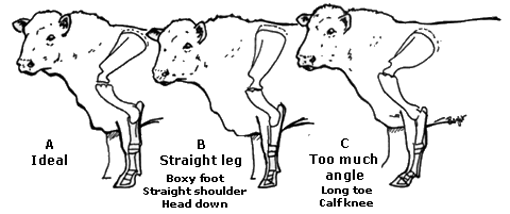
The straight-shouldered bull tends to walk with a short choppy gait. He will carry his head low and may have difficulty raising his head much above his backline. Quite often the tip of the shoulder blade is prominent above his backline.
Usually, a bull that is straight in the shoulder will also be straight in the hind leg. These bulls are particularly prone to early breakdown through the wearing of the leg joints, and the onset of arthritis. While many straight-shouldered bulls will break down in the hind leg, they are also more susceptible to arthritis in the pasterns and knees of the front leg. Straight-shouldered bulls may also be straight in the pasterns, causing rapid wearing of the front of the hooves.
The shoulder should be smooth against the rib cage. Bulls whose shoulders are wide at the point of the shoulder (the base of the neck) or wide between the shoulder blades (when observed from above) may throw heavily shouldered calves, increasing the chance of calving problems (see Figure 2).
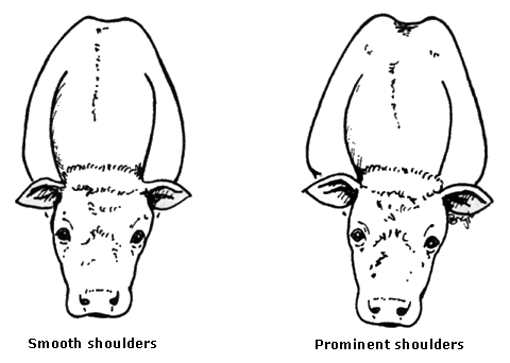
Bulls with straight shoulders may also affect the ease of calving. Any deviation away from the normal angles of the calf may produce an abnormal calf shape, causing calving difficulty.
It should be remembered that many things affect calving difficulty, and that calf size (weight) in relation to dam pelvic size will have the greatest effect on ease of calving.
Front legs and feet
The front legs of the bull should be straight when viewed from in front. On a structurally sound animal, a vertical line may be drawn from the point of the shoulder to the middle of the claw. This line should intersect the knee (see Figure 3 below).
As the knee joints carry more than half the bull’s body weight, deviations from this line may cause excessive wearing of these joints.
A ‘knock-kneed’ bull may have turned-out front feet (up to 10 degrees is considered normal). A bull is considered ‘knock-kneed’ when the knee joints lie inside this line, which may eventually lead to overgrown outside claws.
A bull that is wide at the knees (bow-legged) presents a more serious problem. These animals are often narrow in their stance and may roll their feet as they walk. They can also be wide in their shoulders.
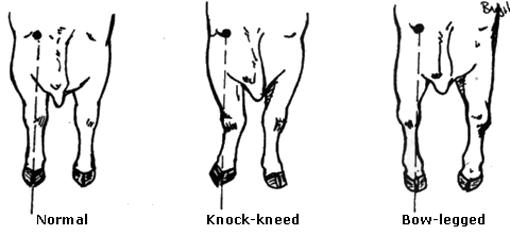
From the side, the forearm and cannon bones should be in a straight line. A knee joint forward of this line (buck-kneed) can be associated with steep shoulders and pasterns, and may be a serious fault.
A knee joint set back of this line (calf-kneed) may be associated with sloping shoulders and has little impact on function.
The way the claws of the feet grow often indicates structural problems higher up the legs. Long or excessively short even claws may indicate too much or not enough pastern angle, causing both claws of the hoof to grow or wear excessively. Overgrown claws affect the mobility and performance of the animal. Figure 4 indicates the correct angle of the pastern joint.
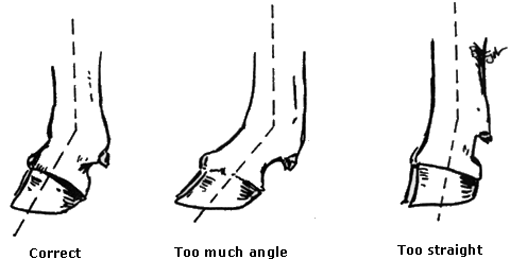
Uneven wearing of the two claws, where one grows longer than the other, is often due to a problem in the leg structure. It is caused by an uneven distribution of weight through the foot.
If the claws curl across each other without growing long, a serious genetic fault (‘scissorclaw’) may be apparent. These cattle wear the back of the hoof, causing lameness and reducing mobility.
Where excessive claw growth is caused by things other than structure (soft soil, heavy grain feeding, lack of exercise), extra pressure is placed on the leg joints, eventually causing lameness.
Feet
Avoid overgrown, scissor or curved claws (see Figure 5). Mild curling is normal. It is exaggerated by heavy feeding and soft soils. Overgrown, uneven claws are usually indications of poor limb structure or early signs of hip arthritis. Avoid extremely short feet, which are often associated with overstraight legs.
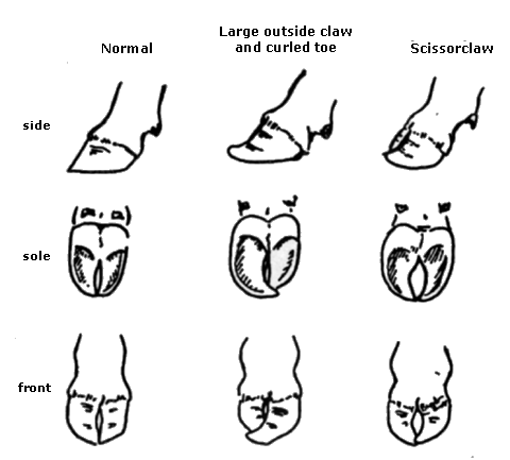
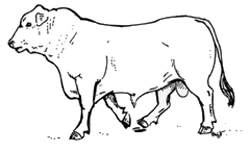
Walk
Look for a free-moving gait, with the hind feet stepping into the footprints of the front feet (see Figure 6 above). Overstepping or understepping are indications of structural problems, as are uneven footprints from the claws.
Hind legs and feet
The structure of the hind legs is similar to that of the front legs. Again there are well-defined angles in the joints at the hip, stifle, hock and pastern joints. The angles are critical, particularly during serving when large amounts of stress are placed on these joints. Deviations from the correct angles (see Figure 7 below) will cause excessive wear and tear on the joints, leading to early breakdown. More bulls seem to break down from problems associated with the hind leg than from any other reason.
Too much angle in the leg joints (straight-legged) is a serious structural fault. These cattle don’t have the flexing and shock-absorbing effect of the structurally sound animal, and they are prone to severe wearing of the hip joint, leading to arthritis. Bulls showing arthritic problems are reluctant to serve many cows, as the condition can be quite painful.
When a bull mounts a cow, he straightens up the joints in his hind leg. When he thrusts, he further straightens the leg, placing enormous stress on all joints, but particularly the hock. If these joints don’t have enough angulation, they become swollen and painful, leading eventually to their breakdown.
Straightness in the hind leg can be seen in the hock and pastern joints, and this indicates straightness in the stifle and hip. These cattle will wear the front of the claws, resulting in short upright hooves.
Straight-legged bulls are also much less athletic than the sound bull and appear to suffer a higher incidence of broken or damaged penises during serving.
A structurally correct bull, when walking, will place his hind foot in exactly the mark left by his front foot. If he is lame, or not moving freely, or if he is straight in his leg structure, he will short-step and not reach his mark. Likewise, if he is suffering arthritis in one leg he may tend to short-step or drag his leg on that side. Problems such as these will affect the serving ability of the bull.
If the degree of the angle in the leg joints is less than ideal, ‘sickle hocked’ condition may exist. This is less of a problem than straight legs, but in extreme cases may cause strained ligaments (pastern and hocks) and long claw growth, increasing the chance of injury, and affecting serving ability. Sickle-hocked bulls may overstep the mark of the front feet as they walk out.
Sickle-hocked bulls appear to have less balance than do sound bulls. They may lose their balance during serving, therefore running a higher risk of injury.
Viewed from behind, the tibia and metatarsus (hock joint) should be in a straight line. A bull is ‘cow hocked’ when the hocks are rotated inwards and the hooves rotated outwards. This may cause problems but usually only in extreme cases where uneven pressure on the claws may cause the outside claw to grow long.
A more serious problem occurs where the legs are wide at the hocks (‘bow-legged’), but the feet are turned in. Extra strain is placed on the ligaments of the hock joints causing lameness and even permanent damage.
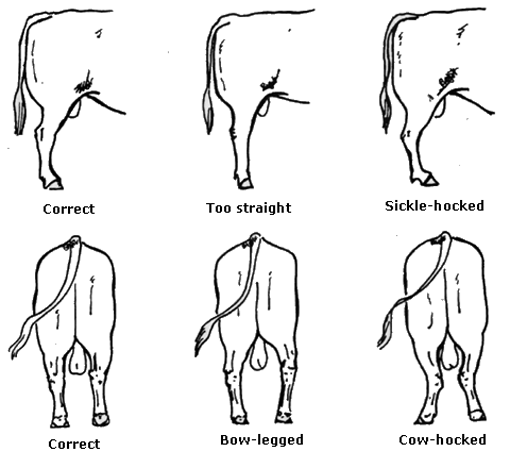
Leg angulation
Avoid:
- Post legs (straight hocks) (see Figure 8a)
These cattle generally walk short and have worn ‘boxy’ toes. They are prone to arthritis in the hips and other joints, and damage to the ligaments. Penis damage can occur due to serving accidents, as these bulls have poorer balance than do structurally correct bulls. Libido will naturally decline. - Sickle hocks (the opposite to straight hocks) (see Figure 8b)
The joints are over-angled, leading to overstepping and long overgrown claws and lameness. Moderate cases are not a concern, but bad sickle hock strains ligaments, damages the dew claw and affects serving ability.
| 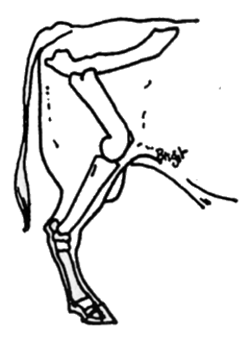 |
Notes
- Many of the above symptoms are at least partly genetic. They can be exaggerated by factors such as overfeeding, mineral deficiencies and soft soil. Hoof trimming can temporarily hide some problems.
- Grass-reared or lightly fed bulls have fewer structural problems and longer working lives, as do well-managed yearling bulls. Their body weight as they develop is more in keeping with the weight-bearing ability of their joints.
The sheath
The sheath should be trim and close to the body (see Figure 9). A long sheath or an excessively angled sheath is more prone to injury or infection (from grass seeds or other foreign objects) and should be avoided. Some breeds are more susceptible to these problems and buyers of these cattle must be critical in their selection.
A slack prepuce (the fold of skin covering the penis) should also be avoided. A bull who lets his prepuce hang out for long periods of time should be regarded as having a serious structural fault.
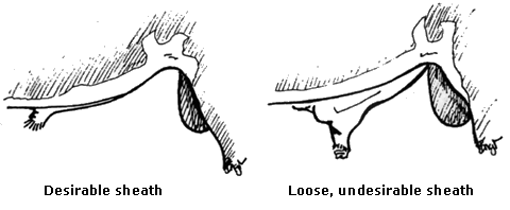
Top line
The width of the bull’s top line will help indicate the animal’s muscling. Heavily muscled bulls will be wide and bulging in their top line, especially behind the shoulder, and in the loin.
Conclusion
Observing each of these features, in the routine suggested, will ensure that no structural aspects of the bull have been missed. Quite often you’ll notice an obvious fault such as straight legs or uneven hoof growth immediately. You can note this and move on to the next bull.
A routine such as this will enable large numbers of bulls to be checked quickly.
The visual examination should be combined with an assessment of any performance (BREEDPLAN) or fertility information on the bull, to give a balanced appraisal of that animal.
Further information
This publication is adapted from NSW Agriculture’s Better Bull Buying manual. Other publications adapted from this manual include:

